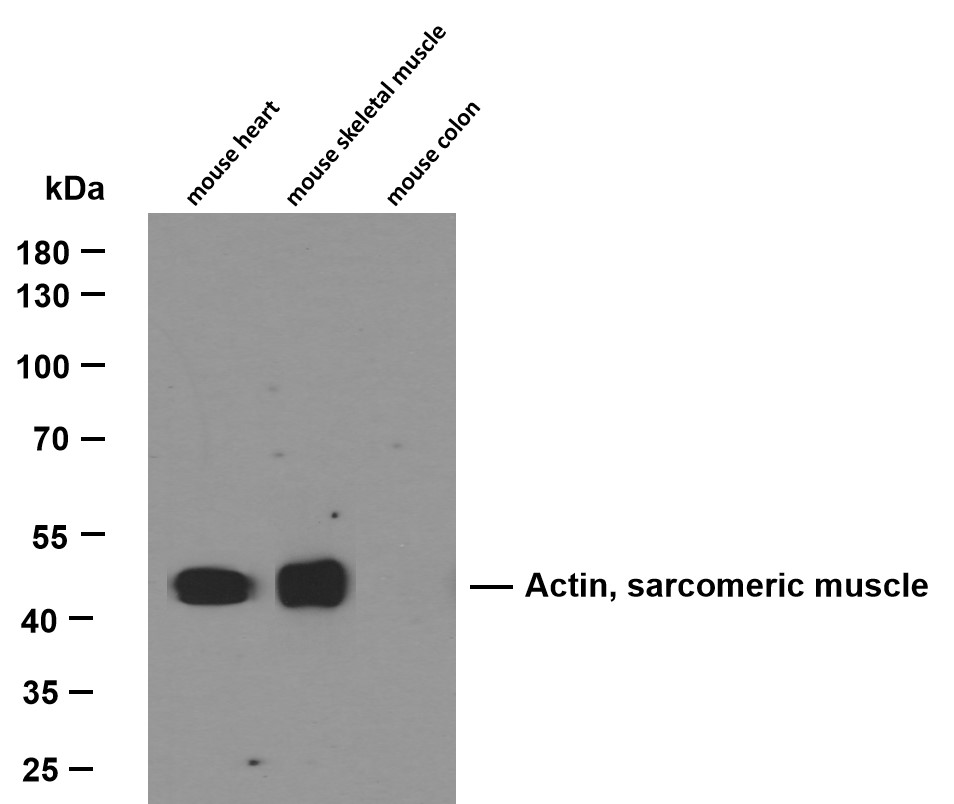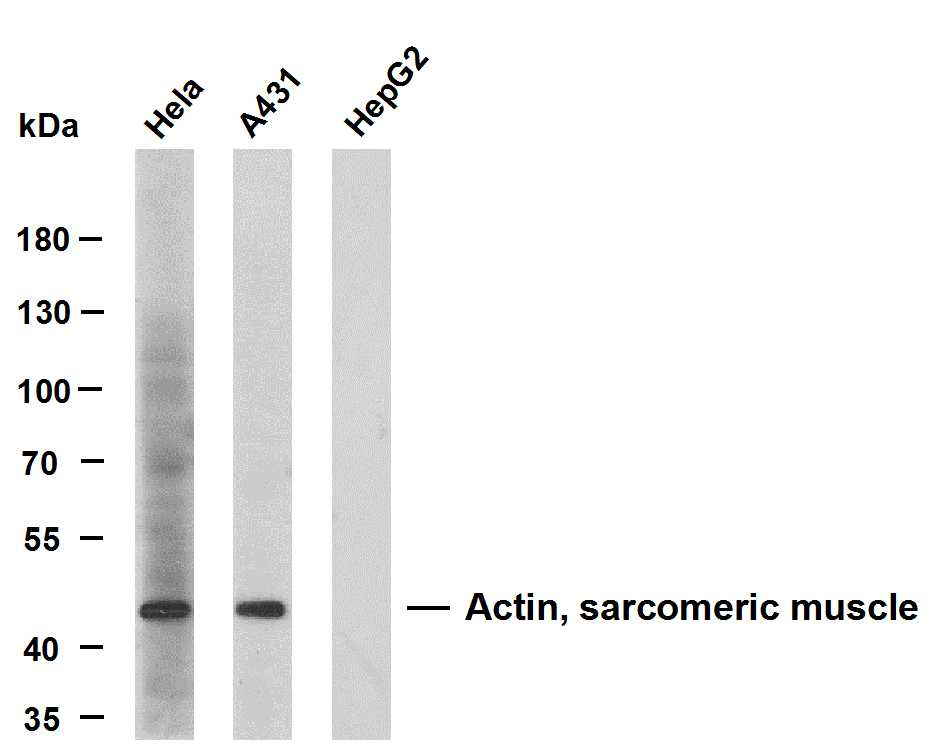Actin, sarcomeric muscle (ABT-SCA) mouse mAb
- Catalog No.:YM6671
- Applications:WB; IHC;ELISA
- Reactivity:Human; Mouse (predicted: Rat; Bovin; Pig; Chick)
- Target:
- Actin, sarcomeric muscle
- Gene Name:
- ACTB ACTC1
- Protein Name:
- Actin, sarcomeric muscle
- Human Gene Id:
- 375/377
- Human Swiss Prot No:
- P68133/P68032
- Immunogen:
- Synthesized peptide derived from human Actin, sarcomeric muscle AA range: 2-50
- Specificity:
- This antibody detects endogenous levels of human Actin, sarcomeric muscle. Heat-induced epitope retrieval (HIER) Citrate buffer of pH6.0 was highly recommended as antigen repair method in paraffin sec
- Formulation:
- Liquid in PBS containing 50% glycerol, 0.5% BSA and 0.02% sodium azide.
- Source:
- Mouse, Monoclonal/IgG1, Kappa
- Dilution:
- IHC 1:200-400,WB 1:100-2000, ELISA 1:5000-20000
- Purification:
- The antibody was affinity-purified from mouse ascites by affinity-chromatography using specific immunogen.
- Storage Stability:
- -15°C to -25°C/1 year(Do not lower than -25°C)
- Molecular Weight(Da):
- 42kDa
- Observed Band(KD):
- 42kDa
- Background:
- The product encoded by this gene belongs to the actin family of proteins, which are highly conserved proteins that play a role in cell motility, structure and integrity. Alpha, beta and gamma actin isoforms have been identified, with alpha actins being a major constituent of the contractile apparatus, while beta and gamma actins are involved in the regulation of cell motility. This actin is an alpha actin that is found in skeletal muscle. Mutations in this gene cause nemaline myopathy type 3, congenital myopathy with excess of thin myofilaments, congenital myopathy with cores, and congenital myopathy with fiber-type disproportion, diseases that lead to muscle fiber defects. [provided by RefSeq, Jul 2008],
- Function:
- disease:Defects in ACTA1 are a cause of congenital myopathy with excess of thin myofilaments (CM) [MIM:102610].,disease:Defects in ACTA1 are a cause of congenital myopathy with fiber-type disproportion (CFTD) [MIM:255310]; also known as congenital fiber-type disproportion myopathy (CFTDM). CFTD is a genetically heterogeneous disorder in which there is relative hypotrophy of type 1 muscle fibers compared to type 2 fibers on skeletal muscle biopsy. However, these findings are not specific and can be found in many different myopathic and neuropathic conditions.,disease:Defects in ACTA1 are the cause of nemaline myopathy type 3 (NEM3) [MIM:161800]. Nemaline myopathy (NEM) is a form of congenital myopathy characterized by abnormal thread- or rod-like structures in muscle fibers on histologic examination. The clinical phenotype is highly variable, with differing age at onset and severity.,func
- Subcellular Location:
- Cytoplasm, cytoskeleton.
- Expression:
- Epithelium,Skeletal muscle,
- June 19-2018
- WESTERN IMMUNOBLOTTING PROTOCOL
- June 19-2018
- IMMUNOHISTOCHEMISTRY-PARAFFIN PROTOCOL
- June 19-2018
- IMMUNOFLUORESCENCE PROTOCOL
- September 08-2020
- FLOW-CYTOMEYRT-PROTOCOL
- May 20-2022
- Cell-Based ELISA│解您多样本WB检测之困扰
- July 13-2018
- CELL-BASED-ELISA-PROTOCOL-FOR-ACETYL-PROTEIN
- July 13-2018
- CELL-BASED-ELISA-PROTOCOL-FOR-PHOSPHO-PROTEIN
- July 13-2018
- Antibody-FAQs
- Products Images

- Various whole cell lysates were separated by 10% SDS-PAGE, and the membrane was blotted with anti-Actin, sarcomeric muscle (ABT-SCA)) antibody. The HRP-conjugated Goat anti-Mouse IgG(H + L) antibody was used to detect the antibody. Lane 1: mouse heart Lane 2: mouse skeletal muscle Predicted band size: 42kDa Observed band size: 42kDa

- Various whole cell lysates were separated by 8% SDS-PAGE, and the membrane was blotted with anti-Actin, sarcomeric muscle(ABT-SCA)antibody. The HRP-conjugated Goat anti-Mouse IgG(H + L) antibody was used to detect the antibody. Lane 1: Hela Lane 2: A431 Lane 3: HepG2 Predicted band size: 42kDa Observed band size: 42kDa
_wb.jpg)
- Western blot analysis of Actin, sarcomeric muscleAntibody at 1:1000 dilution.



